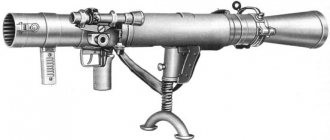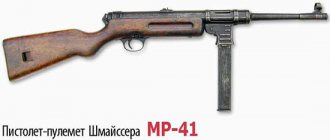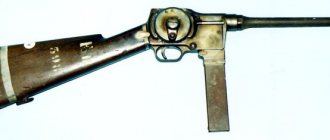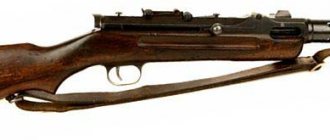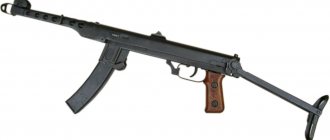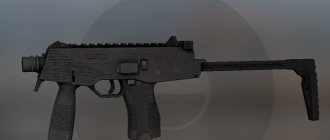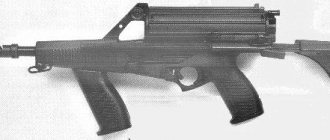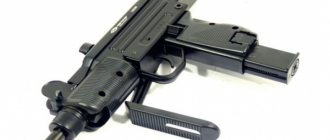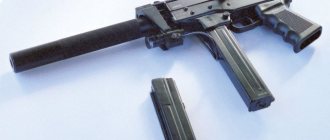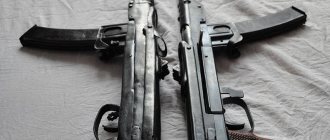Submachine gun Carl Gustaf M/45 (Sweden)
In 1945, the Swedish State Armory, commissioned by the Swedish Armed Forces, urgently developed a new submachine gun that met the requirements of the Swedish army, which was subsequently adopted for service under the designation Carl Gustaf M/45 or Kpist M/45 . This is one of the oldest models of submachine guns still in service, and is a reliable weapon that has attracted users for a long time. The original model did not have a receiver neck and used a disk magazine similar to the Finnish Suomi SMG, but in 1948 a box magazine was developed, and all produced submachine guns were modified to fit it by adding a neck. Carl Gustaf M/45 submachine gun is in service with the armies of Sweden, Ireland and Indonesia, and is produced under license in Egypt under the designation “Port-Said”. A copy of the Carl Gustaf M/45 was released in the United States in the late 1960s and early 1970s by the famous Smith & Wesson company under the designation SW-76, but production was limited (several thousand pieces). The documentation and production rights were then sold to the American company MK Arms, which produced a copy of the Carl Gustaf M/45 under the designation MK-760. The production of the ML-760 was relatively small; they were purchased by some US police units. A deeply modernized modification of the Carl Gustaf M/45, in which the conventional barrel was replaced by a barrel with an integrated silencer, was used by US special operations forces in Vietnam.
Carl Gustaf M/45 submachine gun is a weapon with automatic action based on a blowback action. The fire mode is automatic only, fire is fired from an open bolt. The receiver and barrel casing are cylindrical and made of steel. The magazine neck on the original models was replaceable, in versions for the “native” two-row Swedish-designed magazines with 36 rounds or for four-row box magazines from the Finnish Suomi PP with 50 rounds. Later, in the M/45B modification, replaceable necks and magazines from Suomi were abandoned, since “original” magazines provided greater reliability. The M/45B has an improved rear receiver lock, smaller bores in the barrel shroud, and uses only a 36-round magazine. The reloading handle is located on the right side, is rigidly connected to the bolt and moves with it during firing. The ejection window for spent cartridges is located in the right front part of the receiver above the magazine receiver. The buttstock is steel, folds sideways, sighting devices include a front sight and a flip-over rear sight, designed for ranges of 100 and 200 meters. M/45C modification differs from the M/45B only in the presence of a bayonet mount.
Tactical and technical characteristics of Carl Gustaf M/45Cartridge: 9 mm “parabellum” Full length with folded butt: 808 mm Full length with folded butt: 552 mm Barrel length: 213 mm Weight: 3.90 kg Rifling: 6 right-handed Magazine capacity: 36 rounds Rate of fire: 600 rounds/min
Marking Serial number on top of the bolt box.
Fuses Pull the bolt handle back and insert it into the cutout of the bolt box groove. The bolt can be locked in the extreme forward position by pressing it into the handle, while the other end of the handle, passing through the transverse hole of the bolt, will enter the recess in the wall of the bolt box.
Discharge The magazine release is located behind the receiver neck. Disconnect the magazine and pull the bolt back. Inspect the chamber, release the bolt, pull the trigger.
9mm Model 45 submachine gun
Usually the 9mm Model 45 is called "Carl Gustav" after the manufacturer's name. Common in design and application, it has been in production since 1945 and is widely exported.
The Carl Gustav, used by many countries, including Egypt (in the 1967 war with Israel) and the United States (silent version for special forces in Vietnam), remains in service with the Swedish army.
The 9mm Model 45 was first produced (now part of the FFV concern) in Eskilstuna and is therefore commonly known as the Carl Gustav submachine gun. “Model 45” - has a generally accepted design without any tricks, uses a simple cylindrical receiver and barrel casing with a simple folding butt, hinged on the pistol grip block. Conventional automatic action based on blowback recoil is used; in general, there is nothing remarkable about the Model 45.
But there is still one peculiarity - the store. For many submachine guns, the magazine is one of the weakest points; inside it there is a simple spring that pushes the cartridges towards the receiver. There are frequent cases of misalignment or “biting” of cartridges, which during battle leads to weapon failure. The original Model 45 used the 50-round magazine from the pre-war Suomi Model 37-39, which was considered superior. But in 1948, a new magazine was introduced that held 36 rounds of ammunition, stacked in two rows, which were neatly aligned into one row by narrowing the cross-section (wedge shape) of the magazine box. The new store proved to be extremely reliable and soon began to be copied everywhere. The Model 45/B was offered with an improved magazine box that could accommodate both a Suomi and a wedge magazine. Later models only had a "wedge" magazine.
The Model 45 and Model 45/B became one of the few major exports of Swedish weapons. Large quantities were sold to Denmark and some other countries such as Ireland. Egypt produced the Model 45/B under license under the name Port Side. Indonesia produced a copied model. Perhaps most unusual was the use of the Model 45/B in Vietnam. The CIA received a batch of weapons and redesigned them, providing them with a special barrel with a silencer. The weapon was then used in Vietnam by US special forces for covert operations.
According to many accounts, silent weapons were not very effective and were not used for long.
There are many accessories available for the Model 45, one of the most unusual being the choke tube, which serves as both a dry-fire device and a short-range target practice tool. The nozzle comes complete with plastic bullets, which are torn into pieces when leaving the barrel for safety. These bullets create sufficient gas pressure in the barrel so that automation can operate and even fire a steel ball. This ball can be used for training shooting at a short distance.
Tactical and technical characteristics of the Model 45/B submachine gun
- Caliber, mm: 9 M39V parabellum;
- Weight, kg: charged 4.2;
- Length, mm: with extended butt 808; with folded stock 551;
- Barrel length, mm: 213;
- Initial bullet speed, m/s: 365;
- Rate of fire, rds/min: 550—600;
- Magazine: box-shaped for 36 rounds.
Previous:9mm F1 Submachine Gun
Next article:9mm submachine gun MAT 49
Battlefield Hardline. Submachine gun Carl Gustav M/45
23 Jul 2015 In My videos
I want to talk to you about a unique weapon from Battlefield Hardline M/45 submachine gun . This is the first appearance of this Swedish barrel in a Battlefield series game. At first glance, I didn’t like it because it looked like a terribly cheap stamp and didn’t particularly please me with its characteristics until the release of the second patch. But now this is one of my favorite pads in the game, which is amazingly easy and pleasant to mow down enemy agents in all game modes.
A little history. Even during World War II, the Swedish armed forces decided to say goodbye to the morally and technically outdated Finnish Suomi submachine guns, produced under license. And already in 1945, a replacement was adopted for service, developed and produced by the Swedish state arms company Carl Gustav. The new product was put into service under the name Kpist M/45. It was a massive submachine gun, made by stamping from steel parts, with a folding rectangular buttstock made of steel tube. The weapons were simple and cheap to manufacture. The stores were used straight for 50 rounds of 9x19 mm Parabellum from Suomi, of which there were plenty in the army.
In 1948, the company developed its own 36-round magazines and the model received a new name - M 45B. In this form, with minor modifications, this submachine gun remained in service with the Swedish army until the 90s. It was very easy to maintain and incredibly reliable. Interestingly, it only supported automatic firing mode, but experienced shooters could achieve single shots; the low rate of fire of 600 rounds/minute allowed this. Later, a police version, the M/45E, was released, which allowed single-shot fire.
Carl Gustav M45 was exported in huge quantities and produced under license in many countries. For example, in Egypt it was produced under the name "Port Said" for a licensed copy, a modified version is known as "Aqaba". The United States purchased the Carl Gustav M45 for its elite Navy SEAL unit during the Vietnam War. In the states, for the needs of police departments, the M45 was produced under license from the late 60s to the mid-80s.
In Hardline, the M45 is available to police mechanics for the ridiculous price of 9,000 in-game dollars. The purchase costs pay off incredibly quickly. Carl Gustav is very good in close combat and at medium range. It feels very similar to the bandit UZI, but I feel more comfortable aiming at enemy infantry with Carl Gustav, from the hip the UZI is, of course, better.
Max. damage - 34 to 18 m min. damage - 20 from 35 m rate of fire - 600 rounds/min. bullet flight speed - 390 m/s bullet flight speed (silencer) - 200 m/s magazine - 36 rounds ammunition - 180 rounds full reload - 2.86 s tactical reload - 2.1 s
Carl Gustav's maximum damage is very high. Before the release of the second patch, the M45 was a frankly weak submachine gun, unable to compete with other guns due to its low minimum damage and short distances for maximum and minimum damage. These parameters were significantly increased and the result was a killer unit, not an imbecile, but a very worthy barrel.
The M45 allows you to earn a frag with three bullets up to 20 meters, four up to 28, five up to 33 and six bullets at longer distances.
Since the speed of a bullet when using a silencer drops to 200 m/s, just forget about it. With a low rate of fire of 600 rounds/minute and such a bullet speed, using a silencer is pointless, especially when working at a distance.
A large magazine of 36 rounds allows you to confidently rush. This is facilitated by excellent reload speed indicators; these are not top-end values, but very decent.
After suffering with the wretched Tommy gun, the M45 feels like just a fabulous fragger in a fight in the Quarter. We conduct aimed fire without clamping down, but in a short burst.
The submachine gun is very accurate and easy to control thanks to good dispersion parameters in all firing modes.
The M45's recoil is predictable and easily controlled - slightly up and to the right. My assembly is as follows - a thickened barrel, a laser target and a single-shot sight. The thicker barrel reduces upward and horizontal recoil by 20%. The laser laser reduces spread when firing from the hip.
The M45 allows you to work confidently at close and medium distances. This is one of my favorite guns in the game.
Battlefield Hardline
Carl Gustaf M4 grenade launcher
"Carl Gustav" (full name Swedish: Granatgevär m/48 Carl Gustaf, abbreviated Swedish: Grg m/48, literally grenade launcher of the 1948 model "Carl Gustav") - a Swedish hand-held anti-tank grenade launcher, named after the company that produced it, Bofors Carl Gustaf AB . The grenade launcher is designed to destroy armored targets, manpower and enemy firing positions, as well as to create smoke screens and illuminate the area.
TTX (tactical and technical characteristics) of the Carl Gustaf M4 grenade launcher:
- Caliber 84 mm
- Shot 84×246 mm R
- Shot weight 3.1 - 4 kg
- Unloaded weight about 7 kg
- Length approx. 1,000 mm
- Initial speed 230 - 255 m/s
- Firing rate up to 6 rounds/min
- Effective fire range (against tanks) up to 400 m
- Effective fire range (against buildings and stationary targets) 700 - 1,000 m
As reported by Jane's Defense Weekly magazine in the article by Nicholas de Larrinaga "Saab unveils Carl Gustaf M4", the Swedish group Saab AB at the Bofors test site in Karlskoga (Sweden) on September 24, 2014 carried out demonstration firing of the Carl Gustaf M4 hand-held anti-tank grenade launcher - the latest version the world-wide 84-mm rifled RPG Carl Gustaf, produced in various versions since 1948
The Carl Gustaf M4 was developed by the Saab Dynamics division, which in 1999 acquired part of the production of the former Bofors company, including production and rights to the Carl Gustaf series RPGs. Saab Dynamics hopes to complete testing of the Carl Gustaf M4 modification in 2015 and begin its mass production in 2016, while due to the relatively high cost of the new version, its production is initially planned to be carried out in parallel with the currently produced (since 1991) Carl Gustaf M3 RPG.
The main difference of the M4 version was a significant reduction in the weight of an unloaded RPG - to 6.7 kg, against 9.7 kg for the M3 modification, and 14.2 kg for the M2, which is still widely used. This is achieved mainly through the use of a titanium barrel with a carbon nozzle in the M4, instead of the steel barrel on the M3. In general, the weight of the barrel in the M4 is reduced by 1.1 kg, and the weight of the nozzle by 0.8 kg. The barrel length was reduced from 1065 to less than 1000 mm. It is stated that the barrel life remains the same - 1000 shots, and a shot counter has been added. A double fuse has also been introduced, which allows you to carry an RPG loaded (this was prohibited in previous modifications).
Standardly, the M4 uses the same optical sight as the M3, but the new version has a Picatinny rail, which allows you to mount a wide range of sighting equipment. The front handle is also mounted on the same rail, which can be replaced with a remote launch system for mounting an RPG on armored vehicles, etc. It is reported that Saab plans to develop an “intelligent sight” for the M4, which will allow the use of advanced ammunition with programmable detonation.
There are currently 11 different types of Carl Gustaf RPG grenades available on the market. The development of a new generation of programmable detonation ammunition for the M4 will further increase the operational flexibility of this weapon. Saab AB also announced the development of a conceptually new family of Ultra-Light Missile ammunition for the M4, which will ensure target acquisition before launch, have a wide range of warheads and a firing range of up to 1500-2000 m.
